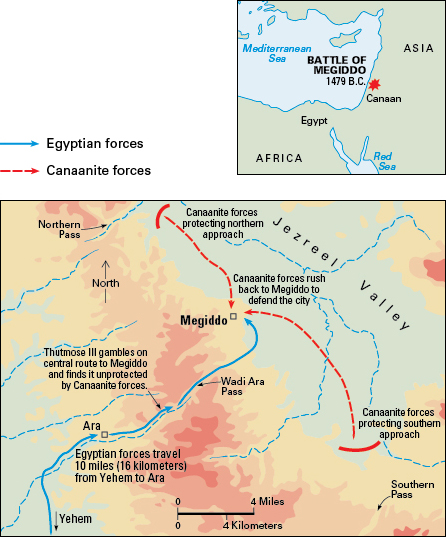Megiddo, Battle of, was fought in 1479 B.C. between the Egyptian forces of Pharaoh Thutmose III and the Canaanites under the king of Kadesh (also spelled Qadesh). It was the first and most famous battle fought at Megiddo, an ancient city in the Jezreel Valley of what is now Israel. The details of the battle fought by Thutmose are inscribed on the walls of the Temple of Karnak in Egypt. The details make up the first known recorded account of warfare. Since 1479 B.C., armies have fought more than 30 battles at or near Megiddo. In the Bible, the site is known as Armageddon (from the Hebrew Har-Megiddo, which probably means Mount Megiddo), the place where the rulers of the world will fight a great battle between good and evil.

Thutmose III became king of Egypt following the death of his aunt and stepmother, Hatshepsut, who had ruled as pharaoh. Upon his rise to the throne, several city-states in the land of Canaan (parts of modern-day Israel, Jordan, Lebanon, and Syria) rebelled against Egyptian rule. Each city-state consisted of a city or town and the surrounding villages and farmland. Led by the king of the city-state of Kadesh, the rebel armies camped around the city of Megiddo and waited for the Egyptians to arrive.
Thutmose gathered his forces and marched north from Egypt into Canaan, reaching the town of Yehem in 20 days. There, the pharaoh and his generals held a war council to consider the ways to get to Megiddo through the mountains on the southern edge of the Jezreel Valley. The central route, through what is often called the Wadi Ara Pass, was the most direct, but it was narrow and dangerous. The route would leave the Egyptian army vulnerable to an ambush. The curving northern and southern routes would take longer but were wider and safer.
The Egyptian generals urged Thutmose to follow either the northern or the southern route. The pharaoh, however, argued that the Canaanite forces would expect this move and attack the Egyptians where the routes opened into the Jezreel Valley. Thutmose predicted that the Canaanites would not expect the Egyptians to follow the more dangerous central route straight to Megiddo. If the Egyptians dashed boldly through the narrow path, Thutmose explained, they would be victorious. Against the advice of the generals, the Egyptians took the central route and found Megiddo unprotected. The Canaanite forces had split, covering the northern and southern approaches but leaving the central route open. Thutmose had been correct.
The Egyptians swooped down toward the undefended city. On their way, however, they stopped to loot the tents and camps of the rebel forces outside the city. This delay gave the inhabitants of Megiddo time to close the city gates. The Canaanite armies finally arrived and were defeated by the Egyptians, but it took Thutmose seven months to capture the city.
The account in the Temple of Karnak tells little of the actual battle, with no details about troop numbers or casualties. It says only, “His majesty set forth in a chariot of fine gold. … The southern wing of his majesty’s army was at a hill south of [the] Qina [brook], and the northern wing was to the northwest of Megiddo, while his majesty was in their center.” Then Thutmose “at the head of his army attacked his enemies, and broke their line, and when they saw that he was overwhelming them they broke and fled to Megiddo in a panic, leaving their horses and their gold and silver chariots on the field.”
According to the temple’s inscriptions, the victorious Egyptians captured 2,041 horses and 924 chariots from the enemy forces. They brought back 340 prisoners and a bronze coat of mail (armor) belonging to the prince of Megiddo. The Egyptian victory in the Battle of Megiddo guaranteed their rule over Canaan for the next several hundred years.
See also Armageddon ; Canaanites ; Hatshepsut ; Karnak, Temple of ; Thutmose III .
